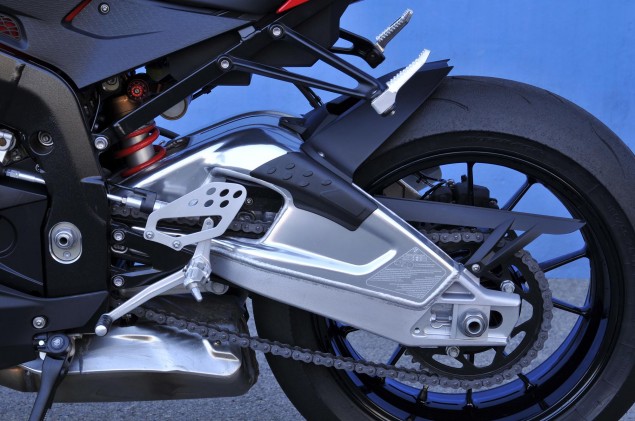BMW did an amazing thing two years ago. Not really known for its performance street motorcycles, BMW took the competitive superbike market head-on, bringing out a motorcycle that not only had class-leading performance figures, but was also priced extremely competitively against its Japanese competitors. That lethal combination of price, quality, and performance made the BMW S1000RR the sport bike to have over the past two years, and it shows in the S1000RR’s sales figures, which eclipsed every other liter bike.
Not wanting to rest too heavily on its laurels, BMW has updated the S1000RR for the 2012 model year, and while the bike may look the same, the German company hopes it has done plenty to its halo bike to make would-be buyers give the S1000RR a good looking over next season, despite going into its third year of production. While the same 193hp engine resides at the heart of the S1000RR, and the curb weight remains a paltry 449 lbs (90% fuel), the 2012 BMW S1000RR gets a bevy of suspension, chassis, and electronics for the new model year.
Though more of an evolution of the company’s first stab at a proper sport bike, perhaps the most notable change to the 2012 BMW S1000RR is the revised frame, which sees a revision to the bike’s steering head angle, offset, swingarm pivot position, fork projection, and spring strut length. BMW has also enlarged the air intake, which goes through the steering head, to have a larger cross-section that results in better air flow to the airbox. Other chassis changes include changes to the suspension internals, along with some cosmetic changes to the bikes fairings (including a new color scheme) and re-vamped gauge cluster. BMW lists the full extent of the changes made to the 2012 BMW S1000RR as the following:
- Optimized torque curve for improved ridability.
- Expansion from two to three performance curves (one each for Rain and Sport modes and an additional one for Race and Slick modes); Rain mode now 120 kW (163 hp).
- Reconfigured throttle for enhanced response (particularly gentle and sensitive acceleration in Rain mode, and immediately direct and spontaneous response in Sport, Race, and Slick modes).
- Reduced twisting force and tighter twist-grip angle.
- Smaller secondary ratio for boosted thrust.
- Refined tuning between Race ABS and Dynamic Traction Control (DTC).
- Enlarged cross sectional area of the intake air guide through the steering head for greater air flow efficiency.
- Better handling, steering accuracy, and feedback.
- Revised spring elements for an even wider range of damping forces.
- Suspension geometry modified with new values for the steering head angle, offset, position of the swing arm pivot, fork projection, and spring strut length.
- New mechanical steering damper adjustable over ten levels.
- Forged and milled fork bridge in a new design and with a smaller offset.
- Revised design with a leaner tail section, redesigned side panels, centre airbox cover with side aperture grilles, and winglets.
- For new colour variants: plain Racing Red with Alpine white, Bluefire, Sapphire black metallic, BMW Motorrad Motorsport colours.
- Revised RR logo.
- New heel plates and leaner stabilisers on the passenger footrests.
- Redesigned LCD engine speed display for better readability and with five dimming levels.
- Instrument cluster with the new functions “Best lap in progress” and “Speedwarning”; deactivation of “Lamp” fault message when headlamp or number plate carrier removed.
- Catalytic converters relocated, so no heat shield necessary.
- Expansion to the optional extras and special equipment ex works.
Source: BMW





































































































































































Comments